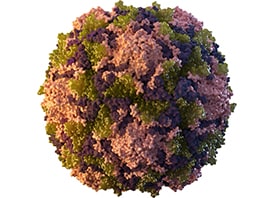At a glance
Poliovirus containment is focused on eradicated polioviruses. Wild poliovirus type 2 (WPV2) and wild poliovirus type 3 (WPV3) were declared eradicated in 2015 and 2019, respectively. Containment measures are in place for laboratories and other facilities that handle or store eradicated polioviruses.

Poliovirus Containment
Polio, or poliomyelitis, is a crippling and potentially deadly infectious disease. CDC and its national and international partners have made significant progress towards polio eradication.
Types of polio
There are three types of wild poliovirus (WPV): type 1, type 2, and type 3. People must protect themselves against all three types of the virus to prevent polio disease.
Type 2 wild poliovirus was declared eradicated in September 2015. The last detection was in India, 1999.
Type 3 wild poliovirus was declared eradicated in October 2019. It was last detected in November 2012.
Only type 1 wild poliovirus remains.
Oral Polio Vaccine
The oral poliovirus vaccine (OPV) is used in many countries to protect against polio disease, as OPV elicits substantial mucosal immunity. Oral poliovirus vaccine contains attenuated or weakened version of one of the following:
- One poliovirus type (monovalent OPV or mOPV)
- Two poliovirus types (bivalent OPV or bOPV)
- All three poliovirus types (trivalent OPV or tOPV)
Switch to bivalent OPV
After wild poliovirus type 2 was declared eradicated in 2015, the world switched from trivalent OPV to bivalent OPV. Bivalent OPV contains poliovirus type 1 and 3. This switch means that the bOPV used globally no longer protects against WPV2. Countries that use bOPV for routine immunization have added a single dose of IPV to protect against WPV2.
Poliovirus variants
In rare instances, the vaccine-virus may be able to circulate over time and mutate in communities with insufficient immunity or immunocompromised individuals. These mutated OPV strains can cause polio disease. They are called poliovirus variants or vaccine-derived polioviruses (VDPVs).
Inactivated Poliovirus Vaccine
Inactivated poliovirus vaccine (IPV) protects people against all three types of poliovirus. IPV does not contain live virus and cannot cause disease. It protects people from polio disease but does not stop transmission of the virus.
OPV can be used to contain a polio outbreak. Use of all OPV will stop when polio is eradicated globally. This will prevent re-establishment of transmission from VDPVs.
